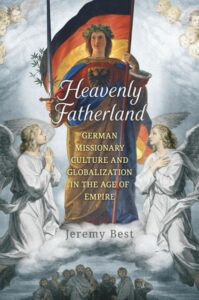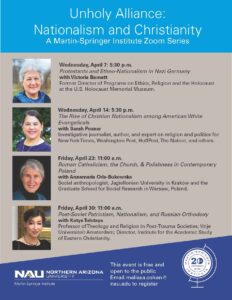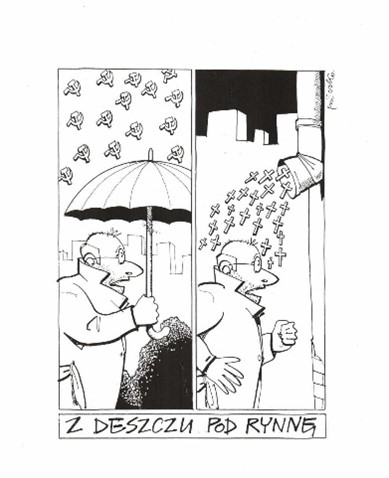Contemporary Church History Quarterly
Volume 31, Number 2 (Summer 2025)
Review of Mirjam Loos, Gefährliche Metaphern: Auseinandersetzungen deutscher Protestanten mit Kommunismus und Bolschewismus (1919 bis 1955). (Göttingen: Verlag Vandenhoeck & Ruprecht, 2020), pp. 266
By Björn Krondorfer, Northern Arizona University
There are many studies about the role of Protestant churches and theology during the Nazi regime and the Holocaust, including examinations of the Kirchenkampf, the so-called Judenfrage, antisemitism, or complicity with or resistance to National Socialist ideology. So far, however, no systematic assessment has been written about anti-communist and anti-Bolshevist sentiments in German Protestantism during the Weimar Republic and the Third Reich. “In the historiography of Protestantism,” Mirjam Loos writes, “a detailed analysis of the anti-Bolshevist rhetoric [Sprach- und Denkmuster]” is still missing (17). Her book, Dangerous Metaphors, is filling this gap.
 Based on her 2017 dissertation in Protestant theology at the Ludwig-Maximilians-University, Loos presents a meticulously researched, insightful, and densely written work on German Protestant attitudes toward communism in general (ideas, ideologies, organizations) and Soviet communist-Bolshevism in particular. Occasionally referencing pre-World War I events, her focus is Germany’s political transition through the Weimar Republic into the Third Reich, tracing the intensification of anti-communist rhetoric on the eve of World War II and the eventual military assault on the Soviet Union in 1941. While the opening chapter points to a few academic-theological debates at the turn of the century on possible family resemblances between the ideals of early Christian and communist communities, the last chapter briefly outlines post-war developments in the Protestant churches until the mid-1950s, with anti-communist stances, though more restrained, remaining largely intact.
Based on her 2017 dissertation in Protestant theology at the Ludwig-Maximilians-University, Loos presents a meticulously researched, insightful, and densely written work on German Protestant attitudes toward communism in general (ideas, ideologies, organizations) and Soviet communist-Bolshevism in particular. Occasionally referencing pre-World War I events, her focus is Germany’s political transition through the Weimar Republic into the Third Reich, tracing the intensification of anti-communist rhetoric on the eve of World War II and the eventual military assault on the Soviet Union in 1941. While the opening chapter points to a few academic-theological debates at the turn of the century on possible family resemblances between the ideals of early Christian and communist communities, the last chapter briefly outlines post-war developments in the Protestant churches until the mid-1950s, with anti-communist stances, though more restrained, remaining largely intact.
Her study might be best described as a historical as well as discourse-critical approach to analyzing how metaphors calling out the evils of communism and Bolshevism operated within a Protestant milieu. Her sources are not limited to academic writings by German theologians or public statements by the Landeskirchen (regional churches). Rather, as Loos puts it, it is a study of processes in the “evangelische Kommunikationsraum,” perhaps best translated as ‘general communication patterns in the German Protestant milieu.’ This Kommunikationsraum includes specific social spaces, organizations, official actors, media, and mechanisms of distribution. Her study thus examines a variety of sources, including sermons, theological journals, educational materials, encyclopedias, official church statements, travel diaries, testimonies, and surveys to stitch together a rich tapestry of the steadily intensifying anti-communist/anti-Bolshevist and, at times, “Bolshevist-Jewish” conspiratorial rhetoric in Protestant milieus. This rhetoric, increasingly divorced from any political reality and analysis, functioned more like a device to first conjure and then combat demonic forces—to a point, as Loos states, that “can only be described as psychotic” (208). The trope in particular of Kulturbolschewismus—an ill-defined, all-encompassing term to assert that Bolshevist ideology has infiltrated every part of German culture and society—eventually established a common ground between German Protestants and Nazi ideology.
The revolutionary events of November 1918 and spring 1919 are the actual starting point of the book’s loosely chronological approach to analyzing Protestant reactions to the threat of communism. Loos focuses on the upheavals during the short-lived “Münchener Räterepublik” and also on violent events in the Latvian capital of Riga. In the latter case, Bolshevist forces murdered Baltic German pastors who, in Christian discourse, were swiftly turned into martyrs. In response to the perceived communist threat, religious leaders (including Baltic German pastors returning from the Gulag) sounded the alarm with first-person accounts, pamphlets, and articles, while paramilitary forces, like the Free Corps (which included pastors and students of theology), fought mercilessly against rebellious workers (Revolutionäre Arbeiterräte). Those events launched the rhetorical patterns of fear that persisted for the coming decades: Bolshevism came to stand in as a general cipher for an attack on religion, Christianity, Germany, and civilization. While at the turn of the century, according to Loos, Protestants mainly took a skeptical stance toward what they called the utopia of communist social ideals, following the violent 1918/1919 events, the ambivalence of German Protestants toward the Weimar Republic increased, blaming Moscow for instigating discord in Germany (like Munich’s Räterepublik) and accusing it for violently repressing Christians in the Soviet Union.
In the following two chapters, Loos examines Protestant responses in the years 1930 to 1932, before Hitler seized power. She mentions the continuing multiplicity of voices in Protestant milieus during those years. On the one hand, there were efforts of solidarity with the persecuted brethren in Russia and protests against the treatment of Christians in the Soviet Union (exemplified by an analysis of official statements coming out of the 1930 Deutsche Evangelische Kirchentag in Nuremberg); on the other hand, German pastors such as the group of “religious socialists,” to which Paul Tillich belonged, were still able to openly identify with socialism and the “proletariat.” Clergy and theologians could still associate with the Social Democratic Party, and special clerical positions were created for a “Proletarierpfarrer” (pastoral care for the working class). Discussions were still nuanced. For example, official church statements condemned religious persecution in the Soviet Union but refrained from demonizing the Soviet social experiment in general. And there were intense internal as well as public debates on the communist memberships of German pastor Erwin Eckert and theologian Fritz Lieb. In the end both were removed from their positions, in the church and at the university respectively. All the while, other voices, today mostly forgotten, pushed a strong anti-Soviet agenda into Protestant Kommunikationsräume. For example, the Baltic German pastor Oskar Schabert condemned with apocalyptic and sexist imagery the anti-church and anti-Christian agenda of Bolshevism: “Satan herrschte, und sein willigstes Werkzeug waren die entmenschten ‚Flintenweiber’, meist junge Dirnen, denen Morden Wollust [war]” (94).* There are also the polemic publications of Iwan Iljin, who had been expelled from Moscow and whose anti-Soviet publications, such as “Gift, Geist und Wesen des Bolschewismus” (Poison, Spirit, and Essence of Bolshevism), reached a wide readership in Protestant milieus. Loos also looks at the travel reports of the few Protestants who had dared to journey to the Soviet Union during those years, like Rudolf Mirbt, who afterward concluded that the Protestant church had to play a decisive role in the final battle (Entscheidungskampf) against Bolshevism.
In chapter 5, Loos examines how the anti-Bolshevist attitudes, which had become a cohesive, identity-building force within Protestantism, enabled the churches to find common ground with Nazism and its anti-Soviet propaganda. The chapter starts with tracing the neologism of Kulturbolschewismus (cultural infiltration of Bolshevism) in 1931 and moves forward to the German invasion of the Soviet Union in 1941. It is a historically and conceptually rich chapter, and any short summary here will not do it justice. But let me say this: important to note is the author’s analysis of the ill-defined yet all-encompassing term Kulturbolschewismus, which became a “cipher for everything ‘evil,’ completely detached from any political ascriptions” (145). At times, this term morphed into the antisemitic trope of “Judeo-Bolshevism.” Loos seems to suggest that the idea of Judeo-Bolshevism, though not absent in Protestant publications, was far more prevalent in Nazi ideology than in Protestant rhetoric. And yet, it is always appalling to realize how leaders of the various regional churches succumbed and conformed to Hitler’s war. For example, when Nazi Germany invaded the Soviet Union in 1941, church leaders, including bishop August Marahrens (Hannover), sent a telegram to Adolf Hitler pledging their support and solidarity: “You have, my Führer, contained the Bolshevist danger in our country and now call on our Volk [people] and all the people in Europe to go into a decisive battle against the mortal enemy of all Ordnung [discipline/rule-based/divinely-willed order] and of the whole occidental-Christian culture” (167). The chapter ends with an apt summary: “In view of the 1936 Spanish Civil War and the attack of the Soviet Union in 1941, various church committees confirmed their loyalty to Hitler and the National-Socialist state” (179).
In the concluding chapter, Loos returns to a conceptual discussion of the role of metaphors regarding anti-Bolshevist rhetoric in Protestant spaces, and how the imagery of nature, meteorology, war, and victimhood morphed into suggestions of a final apocalyptic battle between Christianity and Bolshevism, in which the Soviet Union stood for chaos and darkness and Nazi Germany for light and order. Moving into the post-war period, Loos indicates that anti-Bolshevist sentiments remained intact in Protestant church circles after 1945, especially in West Germany, now under U.S. military administration. Yet, she writes, divergent opinions began to emerge in the 1950s in West German Protestant circles regarding the assessment of danger emanating from the Soviet Union, especially when the question of German rearmament was widely and controversially debated at the onset of the Cold War.
The book ends with a quote from theologian Helmut Gollwitzer, who had been a prisoner of war in the Soviet Union. After the war, Gollwitzer argued for a more differentiated view of communism, suggesting that communism is not “satanic,” though it might be a flawed idea. Coming full circle, Loos writes, we need to know that Gollwitzer had once been a student of Fritz Lieb, the socialist-leaning theologian who had been removed from his university position in 1933.
Notes:
* “Satan ruled, and his most willing tools were the dehumanized ‘gun-toting women’, mostly young prostitutes for whom murder was a source of pleasure.” (Editor’s translation)

 Best, a historian at Iowa State University, pleads for a careful analysis of historical documentation related to German Protestant missionary activities in the nineteenth century within the context of German religious and political culture. His study of “the vast corpus of texts produced by the German missionary movement…between 1860 and the First World War” (7) arrives at the insight that relations between Protestant missionaries and German secular colonial elites were tense and fractured. They did not see eye-to-eye with regards to the purpose of establishing colonies in Africa. German Protestant missionaries aimed for a global Christian community in which the indigenous population (the colonized subject) was given some agency. They recognized the value of indigenous subjectivity that, in their imagination, would blossom economically on local levels, thus protecting them from becoming objects of brutal exploitation in the interest of European nation states, including the late colonial aspirations of the Wilhelmine Empire. What indigenous Africans were missing, according to German Protestant missionaries, was education, and that meant, of course, Christian education.
Best, a historian at Iowa State University, pleads for a careful analysis of historical documentation related to German Protestant missionary activities in the nineteenth century within the context of German religious and political culture. His study of “the vast corpus of texts produced by the German missionary movement…between 1860 and the First World War” (7) arrives at the insight that relations between Protestant missionaries and German secular colonial elites were tense and fractured. They did not see eye-to-eye with regards to the purpose of establishing colonies in Africa. German Protestant missionaries aimed for a global Christian community in which the indigenous population (the colonized subject) was given some agency. They recognized the value of indigenous subjectivity that, in their imagination, would blossom economically on local levels, thus protecting them from becoming objects of brutal exploitation in the interest of European nation states, including the late colonial aspirations of the Wilhelmine Empire. What indigenous Africans were missing, according to German Protestant missionaries, was education, and that meant, of course, Christian education. Because of the relevance of this topic—and propelled by the insurrectionist violence we witnessed at the U.S. Capitol on January 6—the Martin-Springer Institute* put together a 4-part Zoom conversation series on Christian nationalism in April 2021. Titled Unholy Alliance: Nationalism and Christianity, the series took a comparative approach by bringing in voices from different national contexts: Victoria Barnett on “Protestants and Ethno-Nationalism in Nazi Germany”; Sarah Posner on “The Rise of Christian Nationalism Among American White Evangelicals”; Annamaria Orla-Bukowska on “Roman Catholicism, the Church, and Polishness in Contemporary Poland”; and Katya Tolstaya on “Post-Soviet Patriotism, Nationalism, and Russian Orthodoxy.”
Because of the relevance of this topic—and propelled by the insurrectionist violence we witnessed at the U.S. Capitol on January 6—the Martin-Springer Institute* put together a 4-part Zoom conversation series on Christian nationalism in April 2021. Titled Unholy Alliance: Nationalism and Christianity, the series took a comparative approach by bringing in voices from different national contexts: Victoria Barnett on “Protestants and Ethno-Nationalism in Nazi Germany”; Sarah Posner on “The Rise of Christian Nationalism Among American White Evangelicals”; Annamaria Orla-Bukowska on “Roman Catholicism, the Church, and Polishness in Contemporary Poland”; and Katya Tolstaya on “Post-Soviet Patriotism, Nationalism, and Russian Orthodoxy.”